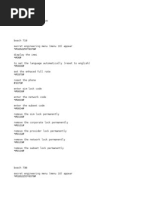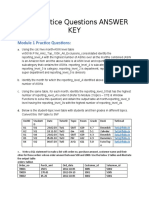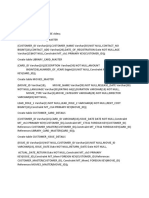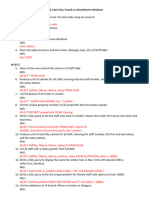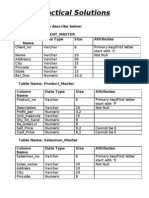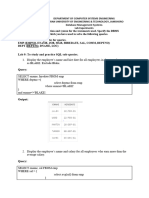Module 4 Assignment - SQL
Uploaded by
Anita BalakrishnanModule 4 Assignment - SQL
Uploaded by
Anita BalakrishnanModule-4 Assignment
Problem Statement:
You have successfully cleared your 3rd semester. In the 4th semester, you will work with inbuilt functions
and user-defined functions
Tasks to be done:
1. Use the inbuilt functions and find the minimum, maximum and average amount from the orders
table
2. Create a user-defined function, which will multiply the given number with 10
3. Use the case statement to check if 100 is less than 200, greater than 200 or equal to 2oo and
print the corresponding value
Solutions
1.
SELECT MAX(amount) AS MAX_AMT FROM orders
RESULT
MAX_AMT
200
SELECT MIN(amount) AS MIN_AMT FROM orders
RESULT
MIN_AMT
100
/2
ANITA BALAKRISHNAN EMAIL annkallid@gmail.com MODULE 4 ASSIGNMENT SQL
-2-
SELECT AVG(amount) AS AVERAGE FROM orders
RESULT
AVERAGE
137
(FOR REFERENCE PURPOSE ONLY Orders table details are shown below)
Order_id order_date amount customer_id
1001 2021-10-15 100 1
1002 2021-10-16 150 2
1003 2021-10-17 100 3
1004 2021-10-18 200 4
2.
CREATE FUNCTION MULTIPLY_BY_10(@NUM INT)
RETURNS INT
AS
BEGIN
SET @NUM=@NUM*10
RETURN @NUM
END
PRINT DBO.MULTIPLY_BY_10(20)
SELECT * dbo.multiply(amount) as multi_Amt FROM Orders
3.
DECLARE @input INT
SET @input=100
SELECT
CASE
WHEN @input<200 THEN 'input is less than 200'
WHEN @input>200 THEN 'input is greater than 200'
ELSE 'input is equal to 200'
END as result
RESULT
result
input is less than 200
ANITA BALAKRISHNAN EMAIL annkallid@gmail.com MODULE 4 ASSIGNMENT SQL
You might also like
- The C# Player's Guide - 5th Edition - 5.0.083% (18)The C# Player's Guide - 5th Edition - 5.0.0497 pages
- Introduction To Computer Theory by Cohen Solutions Manual80% (5)Introduction To Computer Theory by Cohen Solutions Manual198 pages
- Ap Computer Science Principles Practice Exam and Notes 202186% (7)Ap Computer Science Principles Practice Exam and Notes 2021108 pages
- Hacking The Art of Exploitation 2nd Edition Jon Erickson100% (20)Hacking The Art of Exploitation 2nd Edition Jon Erickson492 pages
- PrepTest 83 - Print and Take Test - 7sage Lsat100% (3)PrepTest 83 - Print and Take Test - 7sage Lsat46 pages
- Select As From: Firstname (First Name) Employeedetail100% (1)Select As From: Firstname (First Name) Employeedetail7 pages
- ADD Add Constraint Alter: Keyword DescriptionNo ratings yetADD Add Constraint Alter: Keyword Description5 pages
- SQL Module 2 Assignemt: Presented By: Singaraju Vishnu SharmaNo ratings yetSQL Module 2 Assignemt: Presented By: Singaraju Vishnu Sharma5 pages
- Write A PL/SQL Program To Implement A Simple Calculator100% (1)Write A PL/SQL Program To Implement A Simple Calculator19 pages
- Sample Table - Worker: Perform Following SQL Queries100% (1)Sample Table - Worker: Perform Following SQL Queries2 pages
- Answers To Exercises Given in 9-DEC-2011 Batch Related To HR Schema in Oracle Database 11g100% (1)Answers To Exercises Given in 9-DEC-2011 Batch Related To HR Schema in Oracle Database 11g5 pages
- Coding With JavaScript For Dummies Everything To Know About JavaScript (2020) - 40153100% (1)Coding With JavaScript For Dummies Everything To Know About JavaScript (2020) - 40153247 pages
- NWO, Illuminati, Freemason, Occult, Bible Prophecy, Conspiracy, Secret Society, Etc. LinksNo ratings yetNWO, Illuminati, Freemason, Occult, Bible Prophecy, Conspiracy, Secret Society, Etc. Links47 pages
- Structured and Unstructured Maintenance With Example0% (1)Structured and Unstructured Maintenance With Example9 pages
- Python Programming For Beginners - A Crash Course To Learn Python and Other Recommended Coding83% (6)Python Programming For Beginners - A Crash Course To Learn Python and Other Recommended Coding86 pages
- LINUX COMMAND LINE An Introduction To Linux Command Line EnvironmentNo ratings yetLINUX COMMAND LINE An Introduction To Linux Command Line Environment174 pages
- Learn To Code HTML and CSS Develop Style Websites PDF100% (2)Learn To Code HTML and CSS Develop Style Websites PDF595 pages
- How To Use PATS Module Initialization FunctionNo ratings yetHow To Use PATS Module Initialization Function5 pages








